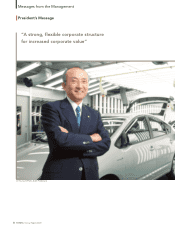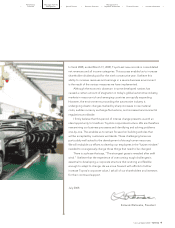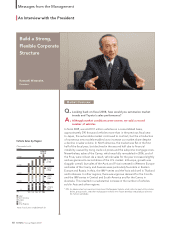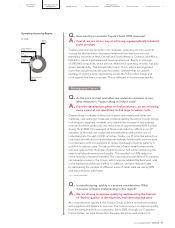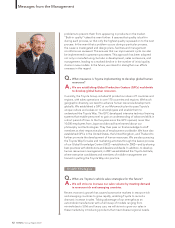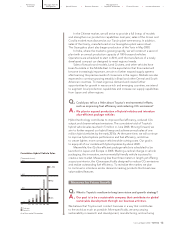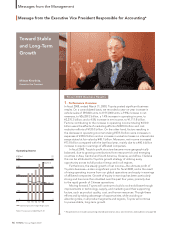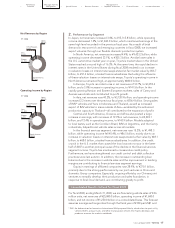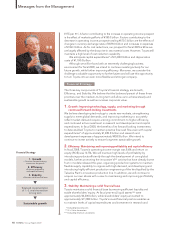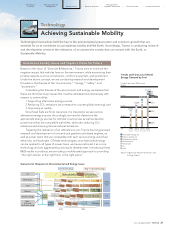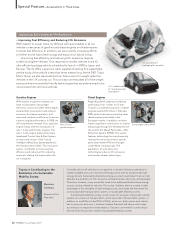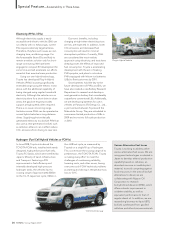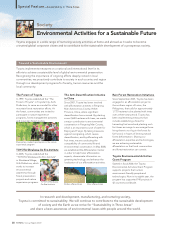Toyota 2008 Annual Report Download - page 20
Download and view the complete annual report
Please find page 20 of the 2008 Toyota annual report below. You can navigate through the pages in the report by either clicking on the pages listed below, or by using the keyword search tool below to find specific information within the annual report.
18 TOYOTA •Annual Report 2008 •
¥155 per 1. A factor contributing to the increase in operating income prospect
is the effect of marketing efforts of ¥180.0 billion. Factors contributing to the
decrease in operating income prospect totaling ¥670.3 billion are the effects of
changes in currency exchange rates of ¥690.0 billion and increases in expenses
of ¥160.3 billion. As for cost reductions, our prospect for fiscal 2009 is ¥0 as we
are largely affected by the sharp rise in raw material costs. However, Toyota still
maintains a high level of cost reduction capability.
We anticipate capital expenditures* of ¥1,400.0 billion and depreciation
costs of ¥1,100.0 billion.
Although we will be faced with an extremely challenging business
environment for fiscal 2009, we intend to continue investing actively for our
future growth, while further improving efficiency. Moreover, we consider this
challenge a valuable opportunity to further kaizen and will use this opportunity
to turn Toyota into an even more flexible and stronger company.
The three key components of Toyota’s financial strategy are Growth,
Efficiency, and Stability. We believe that the balanced pursuit of these three
priorities over the medium-to-long term will allow us to achieve steady and
sustainable growth as well as increase corporate value.
1. Growth: Improving technology, supply, and marketing through
continued forward-looking investments
We believe developing technology to create new markets, strengthening
supply to meet global demands, and improving marketing to accurately
reflect market demand require a strong commitment to higher efficiency,
and continued active investment in research and development and capital
expenditures. In fiscal 2008, the benefits of its forward-looking investments
to date enabled Toyota to maintain positive free cash flow even with capital
expenditures* of approximately ¥1,480.2 billion and research and
development expenses of approximately ¥958.8 billion. We intend to
continue to invest actively to ensure long-term sustainable growth.
2. Efficiency: Maintaining and improving profitability and capital efficiency
In fiscal 2008, Toyota’s operating income margin was 8.6% and return on
equity (ROE) was 14.5%. We will maintain high levels of profitability by
introducing products efficiently through the development of core global
models, further promoting the innovative VI** activity that have already borne
fruit in models released this year, organizing production systems to maintain
flexible supply capability to regions with high demand, and developing and
introducing highly efficient production engineering of the kind typified by the
Takaoka Plant’s innovative production line. In addition, we will continue to
acquire our own shares with a view to maintaining and improving profitability
and capital efficiency.
3. Stability: Maintaining a solid financial base
Toyota maintains a solid financial base by ensuring sufficient liquidity and
stable shareholders’ equity. At fiscal year-end, liquid assets*** were
approximately ¥4,200 billion, while shareholders’ equity amounted to
approximately ¥11,800 billion. Toyota’s sound financial position enables us
to maintain levels of capital expenditures and investment in research and
Financial Strategy
1. Growth
• Continue forward-looking
investment for growth
2. Efficiency
• Enhance profitability
and capital efficiency
3. Stability
• Maintain solid financial base
Sustainable growth
Balanced implementation
of 1.–3. over the medium
to long term
Financial Strategy
*** Excluding leased assets
*** VI = Value Innovation
*** Excluding financial subsidiaries
Messages from the Management


